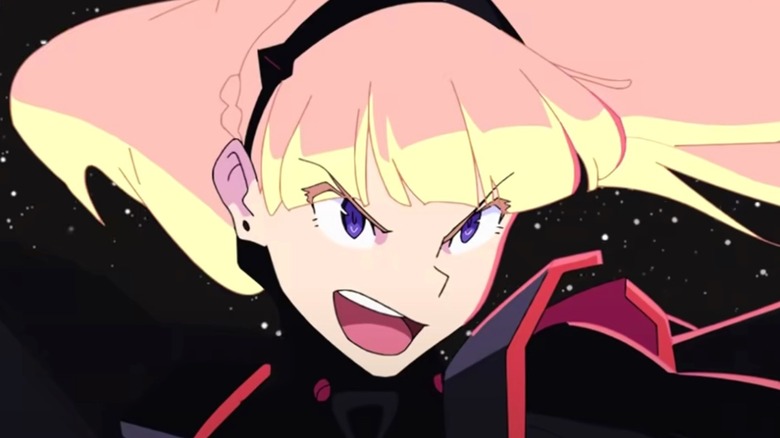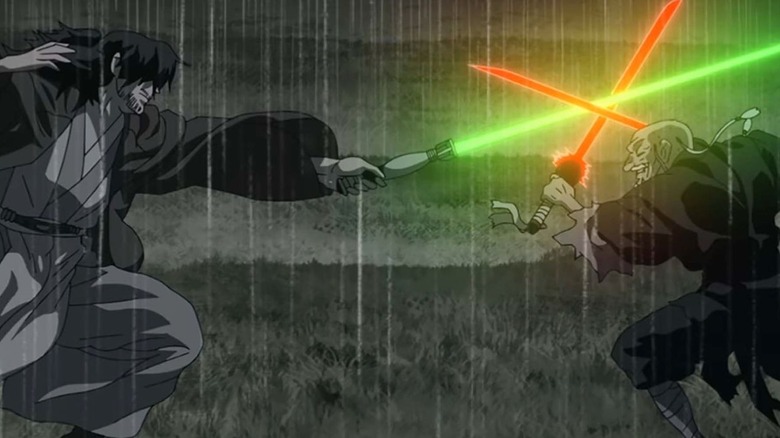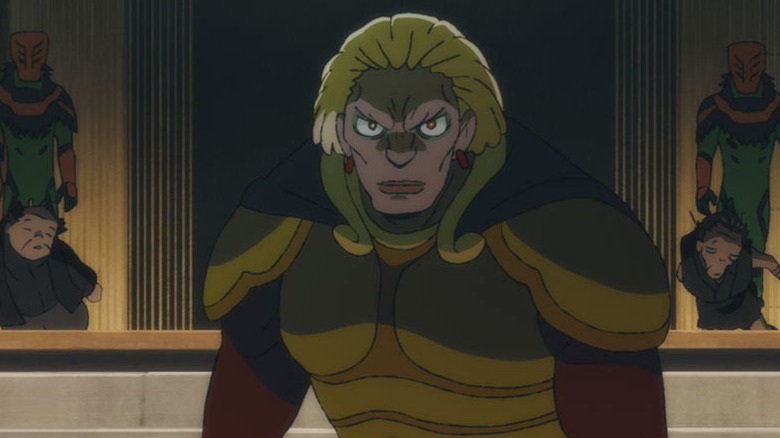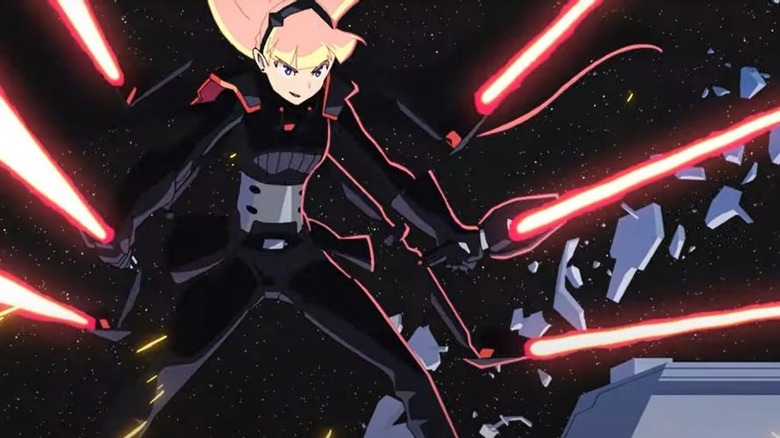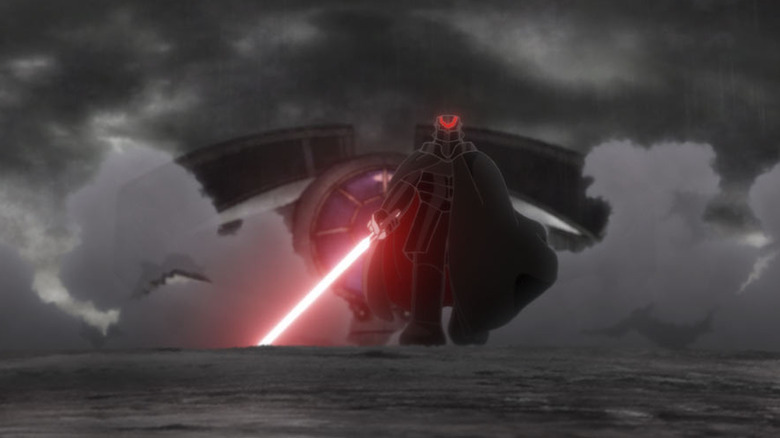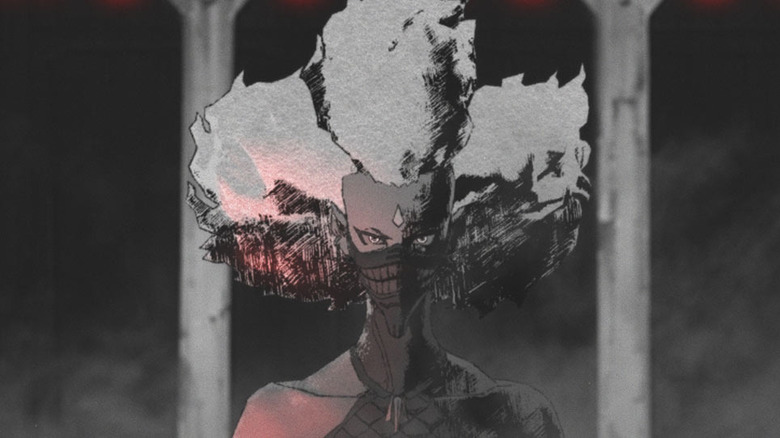Every Star Wars: Visions Villain Explained
Only a short time remains before Disney's collaborative anime experiment using the "Star Wars" universe, "Star Wars: Visions," releases on Disney+. With animation from a veritable who's who of Japanese animation studios, "Star Wars: Visions" provides an anthology of short stories, each with its own distinct artistic spin on the timeless sci-fi franchise. As such, viewers will be introduced to a host of new characters with each vignette. The heroes of these stories play an important role, but "Star Wars" has always been equally lauded for its villains, and boy, does "Visions" have some villains.
For many, the most exciting kind of "Star Wars" villains are the Sith. As the foil to the Jedi's benevolent demeanor, the violent and ruthless Sith prove to be endearing villains who push the normally capable Jedi to their limits. "Star Wars: Visions" capitalizes on this fact heavily, featuring five distinct Sith villains throughout its nine planned shorts. Each has their own unique style and allure. However, they all have one thing in common: The villains of "Star Wars: Visions" are irrefutably evil.
The Elder isn't the Sith you'd suspect he is
Master Yoda, Count Dooku, and Emperor Palpatine all have one thing in common: age. Even in a world of space magic and technology the likes of which we can only dream of, age gets the best of us all. But the Force is bigger than something as paltry as time. As the prequel films were keen on showing, none of these wizened characters need to be young bucks to be a threat. In fact, the time they've spent mastering the ways of the Force, both dark and light, can be more of a reason to fear them.
Much of the same can be said for the eponymous villain of Trigger's "The Elder," an ancient and aging Sith swordsman whose skills have been sharpened to a razor's edge by time and experience. For a dark side user, however, he might not be what you'd expect. "While he appears very Sith-like, he is clearly more focused on mastering his skills than following their ideology," co-executive producer Justin Leach told StarWars.com.
The dark side may be his method for developing his fencing form, but it does not define him. With his eyes set on simply facing strong opponents, the Elder is on a quest to find someone, anyone, who can test his lightsaber skills, a motivation which Leach says "adds a new dimension to the Sith archetype." It's too bad that his strongest opponent, time, may not wield a saber at all.
Masago is the epitome of power
In contrast to the aloof nature of "The Elder," Masago from the Science Saru short, "Akakiri," isn't playing around when it comes to the Sith ideology. The tenants of the Sith and the certainty of destiny motivate this powerful ideologue to espouse her beliefs in all of her words and actions. This is especially true when trying to convert others to her side. Imposing one's beliefs and actions, whether through force or temptation, is the trademark of the dark side. As such, she tries her hardest to make others see things her way. If they don't, well, we're sure you can guess what happens then.
All of this is reflected in Masago's design as well. Her bulky, menace-laden appearance screams of the overpowering and dominating nature of the dark side. "Her red eyes," said designer Naoyuki Asano, "imbued with the power of the dark side of the Force, create the impression of a soul full of darkness, ambition, and a hunger for power." It's a mark of good character design that you can gather certain things about a character's personality from their design details. In Masago's case, we see nothing less than the sheer power that the dark side of the Force can wield over the hearts, minds, and bodies of others.
Am is armored up and ready to go
Returning to Trigger's take on the "Star Wars" world, the short "The Twins" takes a deep look at what happens when two siblings choose very different paths. Raised by the Empire, Karre and his sister Am stand poised to dominate the Galaxy with their new superweapon. However, a vision from the Force emboldens Karre to make a different decision, one that forces him into opposition with his sister both for the good of the Galaxy, and for her own well being.
As much as the twins love each other, though, Am isn't backing down without a fight. With her specialized dark armor modeled after Darth Vader's own suit, she is almost unstoppable. Enhanced by a kyber crystal, her suit emits a veritable hornet's nest of slashes from its attached saber-whips, and her complete faith in the dark side motivates her to push her abilities to their self-destructive limits.
The Inquisitor is on the hunt
People who watched the animated "Star Wars Rebels," read certain comics, or played through "Star Wars Jedi: Fallen Order" are probably familiar with the Inquisitors. These Sith disciples were originally founded and trained by Darth Vader and the Emperor for the purpose of hunting down the remaining Jedi following the order's downfall at the end of "Revenge of the Sith." As it turns out, an Inquisitor is also the villain of Science Saru's short "T0-B1."
Single-minded and animalistic on his hunt for Jedi, the Inquisitor's design reflects the tenacity with which he searches. "As he fights," Leach describes, "he becomes more animal-like, exposing a mouth full of teeth as he screams in anger."
The Inquisitor has every right to be angry, too. The armor-clad warrior — whose resemblance to the Black Knight of legend contrasts his primal behaviors — doesn't target anyone you might expect from a Jedi. A droid (as far as we know) cannot be a Jedi, but T0-B1 endeavors to be the exception. Furthermore, the fact that he tries only seems to bring him trouble, as the Inquisitor ruthlessly eliminates anyone or anything that might invoke the name of the Jedi.
The Bandit Leader is an homage to Japanese tradition
Among the most striking villains in "Star Wars: Visions" is the Bandit Leader. You can probably guess where her paycheck comes from just from the name, but there's much more to this baddy than banditry. The trailer had a lot of fun teasing that umbrella-saber which she wields with impunity in "The Duel," and it's interesting to note that it was included for reasons other than simply looking cool.
Amid the many homages made to Japanese culture — the least of which is not the "Seven Samurai" references that form the foundation of the short — the Bandit Leader's design calls back to onna-musha, the female warrior class of feudal Japan. It's ironic, then, that her greatest challenge comes in the form of a ronin, a masterless samurai, wielding a saber with a katana-style hilt. What follows is a battle that revels in the imagery of a much older Japan, and ends with a fitting homage to the nation's religious traditions.
Thankfully, the battle doesn't end before we get to see exactly what that umbrella does. Traditions aside, the Bandit Leader's coolness factor is off the charts, and her skills with the umbrella have their own modern roots in Darth Maul's double-sided saber from "The Phantom Menace." Of all the villains, the Bandit Leader might be the most upfront about its mixture of Japanese culture and the trappings of "Star Wars."
